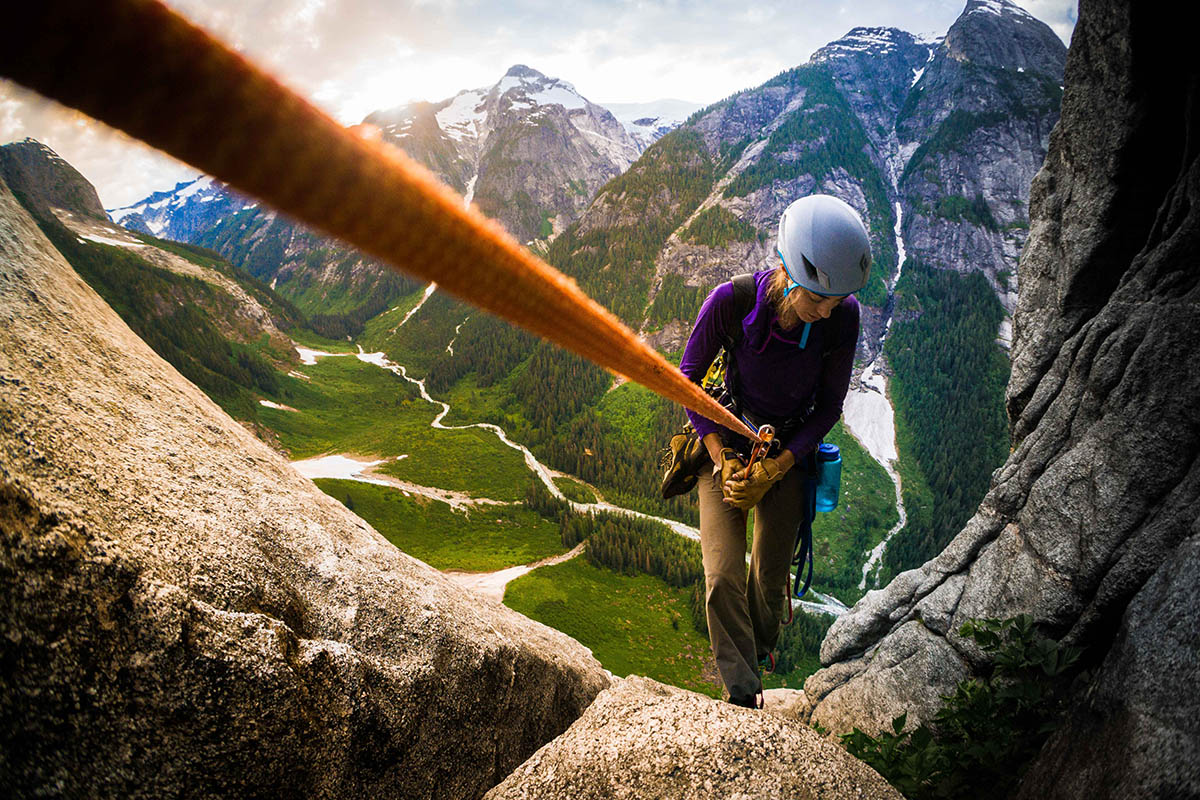
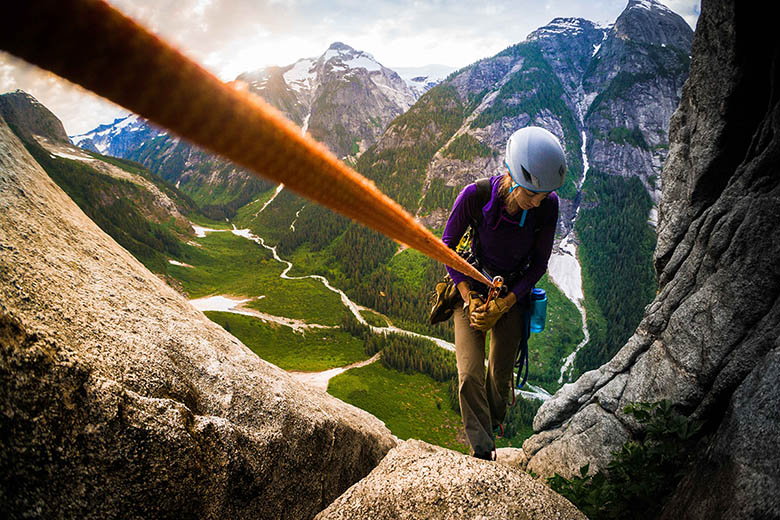
Any piece of climbing gear has the potential to become a cherished relic, but perhaps none carries as many good memories as a trusty old rope. It’s your lifeline on everything from beginning top ropes to full-on alpine epics. A rope is your strongest piece of equipment, and in some ways, your most vulnerable. When you decide to buy a climbing rope, whether it’s your first or fifteenth, it’s worth considering how you plan to use the rope, what technologies are available, and how much you're willing to spend. Below are the best climbing ropes of 2023, and for more background information, see our detailed comparison table and buying advice below the picks.
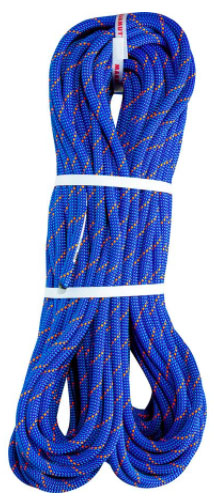 Category: All-around
Category: All-around
Diameter: 9.5 mm
Weight: 59 g/m
What we like: Great size, performance, and durability; always-supple hand feel.
What we don’t: Doesn't have the silkiest sheath; too heavy for serious redpoint climbing.
Had Goldilocks been a climber, she might have lamented about ropes: “this one’s too thin, this one’s too fat.” But when she came to the Mammut 9.5 Crag Dry, she would have snuggled up beside it and said, “this one’s just right.” Indeed, there’s almost nothing not to like about one of the best rope manufacturer’s best ropes. At 9.5 millimeters, it hits that sweet spot between too heavy and too flimsy. It’ll last a lot longer than skinnier ropes at one end of the spectrum, but it won’t drag you down on tough clips high off the deck like a 10-millimeter line. And while the same could be said for any 9.5-millimeter rope, the Crag Dry is not just any 9.5. It is one of the best.
Mammut recently did some reorganizing and formed a “Crag” lineup, but rest assured that their 9.5 Crag Dry is still the same design as their well-loved Infinity Dry. This has been our go-to rope for years, delivering impressive durability for its weight and size. It’s not the silkiest rope out there, but the overall feel is one of smoothness and suppleness. Further, Mammut’s dry treatment, which meets UIAA standards for water repellency, is super effective for a surprisingly long time and keeps dirt out too. As the rope that puts it all together best—price, durability, and feel—we give the Mammut 9.5 Crag Dry our top spot for 2023. For an extra dose of safety and convenience, the Crag Dry is also available in a bi-pattern design (the Crag Duodess) for $320.
See the Mammut 9.5 Crag Dry
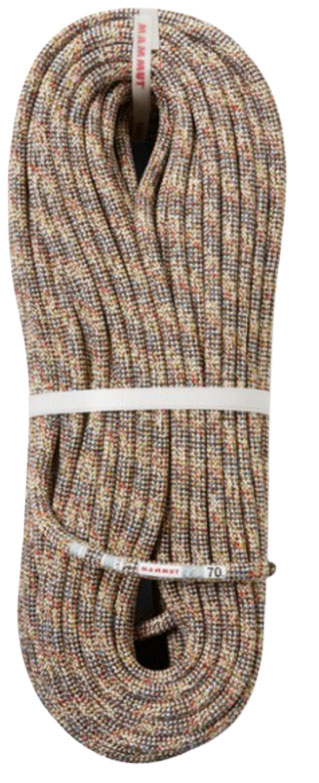 Category: All-around
Category: All-around
Diameter: 9.5 mm
Weight: 59 g/m
What we like: Incredibly affordable and made from recycled materials.
What we don’t: No dry treatment.
As much as we might wax poetic here about rope diameter, sheath feel, and core technology, choosing the right rope doesn’t always need to be complicated. For beginners and casual climbers, it’s really quite simple: You want a reliable rope you can count on to catch you, time after time. And when you’re already breaking the bank to buy shoes, a helmet, quickdraws, the more affordable the rope, the better. Enter the Mammut Crag We Care Classic. For just $190—significantly less than any other rope on the list—you get a decently lightweight 9.5-millimeter rope that’s ideal for everyday cragging, from one of the industry’s most trusted rope manufacturers. Put simply, this rope is a no-brainer for new climbers.
In addition to the price, one of our favorite things about the Crag We Care Classic is that it’s made with leftover yarn from the cutting room floor, so not only are you saving money, you’re also supporting resourcefulness and conservation. And it doesn’t hurt that we’ve actually found Mammut ropes to last a fair bit longer than some of the more expensive competitors. Keep in mind that, like most budget designs, the Crag We Care Classic does not have a dry treatment, which means that sand and dirt will be quicker to penetrate the sheath and wear out the rope. But for those dipping their toes into climbing or who only get out a few times a year, the Mammut is a great option for both top roping and lead climbing.
See the Mammut Crag We Care Classic 9.5
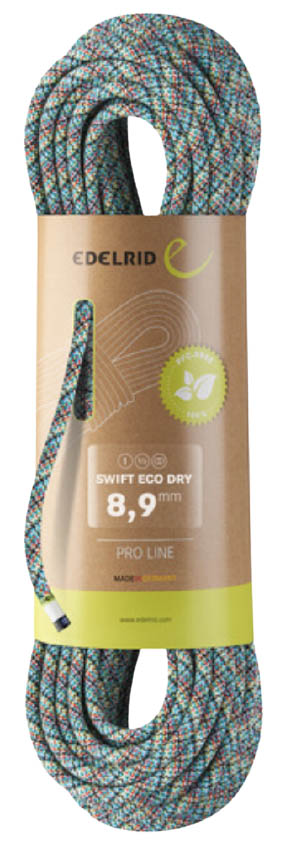 Category: Redpoint/alpine
Category: Redpoint/alpine
Diameter: 8.9 mm
Weight: 52 g/m
What we like: Triple-rated for use as a single, half, and twin; lightweight yet durable.
What we don’t: Not everyone needs such a skinny rope.
Not every climber needs a skinny rope, but when you're 30 meters off the deck pulling moves at your limit, you need every boost you can get. As a result, our favorite sport climbing ropes max out at around 9.1 millimeters in diameter, with some models as skinny as 8.6. The Edelrid Swift is one our favorites: At 8.9 millimeters, it shaves 7 grams per meter off the weight of the models above, which is a difference of over a pound overall. And the skinny Swift isn’t just a single rope—it can also be used as a half or twin line (for more on this, see the buying advice below). This “triple rating” provides an amazing amount of versatility for advanced climbers using one rope in a variety of environments. Take the Swift to the crag as a lightweight redpointing line or pair it with a second for ice climbing or multi-pitch routes with a party of three. In just about every scenario, it’s an ideal fit.
The Swift, however, isn’t totally unique in its versatility. Beal’s Joker and Opera also fit the bill as triple-rated ropes, along with many other models not listed here. But we think the Swift hits the best middle ground in terms of durability, elongation, and weight. Dynamic elongation—how much the rope stretches in the event of a lead fall—is an important number to look at when it comes to skinny ropes (typically, the skinnier the rope, the greater the stretch), and the Swift’s 30% is significantly lower than the 8.5-millimeter Opera’s 40%. Furthermore, in our testing, it has proved to be noticeably more durable and easier to handle than ropes of similar diameter, in large part thanks to its top-shelf dirt- and water-repellant finish. A skinny single rope isn’t for everyone, but for advanced climbers looking for a lightweight and versatile rig, the Swift is our current favorite.
See the Edelrid Swift Eco Dry
 Category: Workhorse
Category: Workhorse
Diameter: 9.8 mm
Weight: 62 g/m
What we like: A time-tested workhorse from a great company.
What we don’t: There are cheaper 9.8s.
Sterling has been making world-class climbing ropes for decades, and the classic Velocity is one of their most successful. At 9.8 millimeters, the Velocity is a real workhorse, and lasts as long as any 10-millimeter rope we've tested. But with smooth handling and a lightweight feel, it doesn't end up feeling like a fuzzy behemoth. Updated last year, the Velocity XEROS features a permanent dry treatment that’s both UIAA-certified and eliminates the use of chemicals.
The Velocity hits a real sweet spot for most climbers. It’s a great buy for beginners who don’t necessarily have all the tricks of the trade when it comes to caring for and maintaining a rope. At the same time, it’s a solid purchase for the seasoned veteran working his or her 5.13 project. It’s not the cheapest rope out there for the diameter, but it lasts a long time. And you have to feel good about supporting one of the only rope companies that manufacture their products here in the U.S. And for those on a budget, it’s worth checking out Sterling’s 9.8-millimeter VR9 ($225 for the 70m), which keeps costs low with minimal color options and a simple DryCore treatment.
See the Sterling Velocity XEROS Dry
 Category: Redpoint/alpine
Category: Redpoint/alpine
Diameter: 8.5 mm
Weight: 48 g/m
What we like: The lightest, thinnest single rope on the market.
What we don’t: Lacks durability; very stretchy.
If you just did a double take when you read the diameter spec, we don’t blame you. The Beal Opera is the skinniest single rope to ever hit the market. In fact, at 8.5 millimeters, it’s the same size as many half ropes. And although we weren’t keen on the Opera right off the bat, after a season of putting it to the test in the Chaltén range of Patagonia, our concerns were laid to rest. It is, quite simply, the best rope for weight-conscious alpine climbers. At 48 grams per meter, it's ridiculously lightweight, beating out competing models like the Edelrid Canary (51 g/m). Plus, the added assurance of Beal’s Unicore technology means the Opera is stronger than its diameter might suggest.
All that said, the Beal Opera certainly isn’t for everyone. In fact, unless you’ve got a big reason to be shaving ounces from your pack, it really is overkill. And even with Unicore technology, there’s no denying the innate compromises of a skinny rope. Notably, the Opera will stretch more than any other rope on our list, and it’s not compatible with older versions of Petzl’s popular Grigri (the modern Grigri can handle ropes as skinny as 8.5 mm). But for alpine climbing—and not much else—these are downsides we are willing to put up with for the extreme weight-savings provided by the Opera.
See the Beal Opera Golden Dry
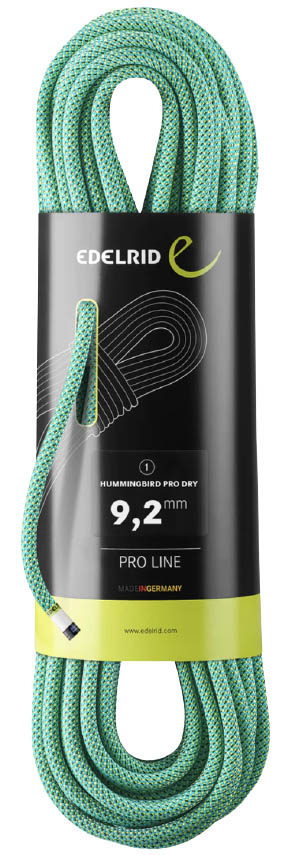 Category: All-around
Category: All-around
Diameter: 9.2 mm
Weight: 57 g/m
What we like: A durable yet skinny all-rounder with remarkably smooth and supple handing.
What we don’t: For some, 9.2 mm is a bit thin for cragging.
We’re big fans of Edelrid ropes, and their wide-ranging lineup includes a just-right model for everyone, from beginner on a budget to 5.14 climber. No matter which you choose, Edelrid's ropes are reasonably priced, remarkably durable (we’ve really put them to the test), and have competitive UIAA fall ratings. In short, it’s hard to go wrong. But if you were to select just one, we'd recommend the all-rounder Hummingbird.
The Hummingbird is one of our favorite cragging ropes, and it stands apart from other 9.2 designs thanks to its particularly fine sheath. Sometimes it’s difficult to notice the subtleties between rope constructions, but the Hummingbird is noticeably supple and fun to handle. And while you can get slightly more life out of a thicker rope like the Mammut 9.5 Crag above and Petzl Arial below, we’ve been impressed with the way Edelrid ropes handle wear and tear. As a result, we'll gladly opt for the Hummingbird as our daily cragging line—and wouldn't shy away from taking it up a demanding multi-pitch, either.
See the Edelrid Hummingbird Pro Dry
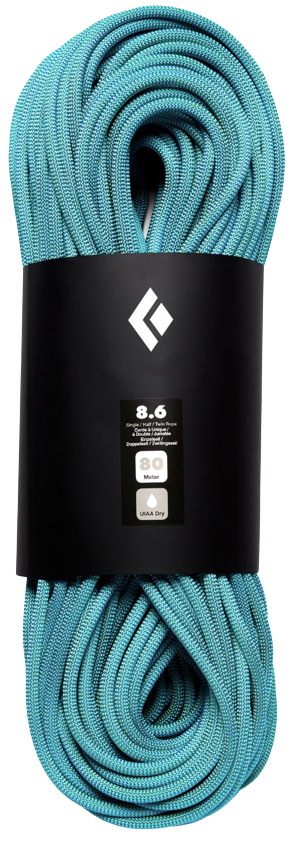 Category: Redpoint
Category: Redpoint
Diameter: 8.6 mm
Weight: 50 g/m
What we like: A staff favorite; durable, smooth-handling, and never too short.
What we don’t: Expensive and not everyone will need an 80m rope.
Edelrid’s Swift is our top redpoint rope of the year, but the Black Diamond 8.6 Dry isn’t far behind. Eighty-meter ropes are becoming more and more necessary for ascending (and lowering off of) routes at many modern crags, and—although we haven’t always been impressed with BD’s rope offerings—the 8.6 Dry is one of our favorites. The rope’s sleek profile is incredibly lightweight, easy to handle, and surprisingly durable: We’ve taken it on two month-long sport climbing trips, and it still feels relatively new. And with a 30% dynamic elongation, it provides the perfect amount of bounce for soft catches (similar to the Swift above).
At $350, the Black Diamond 8.6 Dry is one of the priciest ropes here, but it’s one of the most premium (and the skinniest) ropes in BD’s lineup. The sheath’s 2x2 weave extends its lifespan, and the UIAA-certified dry treatment keeps rocks and sand from penetrating the fibers and causing micro-abrasions over time. An 80-meter rope isn’t for everyone—unless you climb at a crag with pitches longer than 35 meters, you can save some cash with a 70—and the 8.6 millimeter diameter is just about as skinny as we’ll go for cragging. But for the serious climber who needs to keep things light on their long, 40-meter project, it’s a great rope to have.
See the Black Diamond 8.6 Dry x 80m
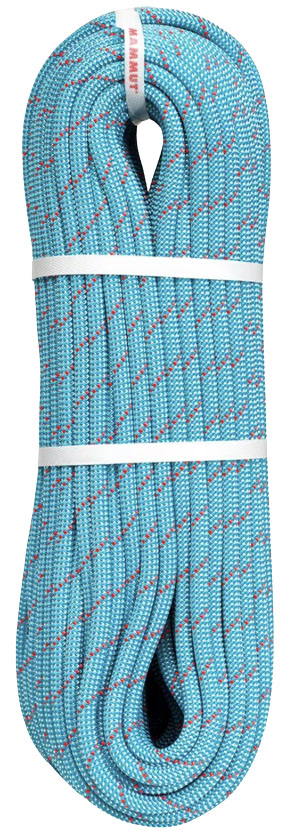 Category: Workhorse
Category: Workhorse
Diameter: 9.8 mm
Weight: 64 g/m
What we like: Quality at a low cost.
What we don’t: Not a high-performance rope.
As we mentioned above, Mammut recently revamped their naming scheme, and the Mammut 9.8 Crag Classic takes the place of the past-generation Eternity Classic. The true highlight of this rope is its price: for only $200, you get the same technology and build quality as our #1 Crag Dry above (read: smooth and supple handling and great durability), but in a workhorse diameter great for top roping. On top of that, the 60-meter version—sufficient for most climbers’ needs—is only $170. If you’re looking for an affordable cragging rope from one of climbing’s best rope manufacturers, the 9.8 Crag Classic is well deserving of a closer look.
But Mammut’s 9.8 does come with some tradeoffs. For one, it’s not exceptionally lightweight (in fact, it’s slightly heavier than its predecessor), meaning you won’t want to drag it up a multi-pitch or be clipping high above your last bolt on your project. And with no dry treatment, it will be quick to take on dust and dirt—you’ll want to pair it with a rope bag or tarp and be sure to give it routine washings. But if gear maintenance and money savings are your cup of tea, the Mammut 9.8 Crag Classic is a superb choice. And Mammut also makes the 9.8 Crag Dry, which features UIAA-approved dry treatment (similar to our #1 pick) for $300.
See the Mammut 9.8 Crag Classic
 Categories: All-around/workhorse
Categories: All-around/workhorse
Diameter: 9.7 mm
Weight: 61 g/m
What we like: Super supple, 8 UIAA falls, affordable.
What we don’t: Can get floppy; no middle mark on non-bi-pattern model.
It’s something of a shame to throw the BlueWater Lightning Pro this far down on the list. In some ways, it is every bit as good as our top cragging workhorse choice, the Sterling Velocity. It handles well, it’s a great diameter and super strong (at 8 UIAA falls, it’s more durable than most options above), and it’s got a pretty durable sheath. Moreover, it’s comparable in cost, and about the same in weight and diameter. So why does the BlueWater fall down to the #9 spot?
The Lightning Pro does last, insofar as the sheath doesn’t wear out and the core stays springy. However, what happens in a very short time is that it starts to get floppy. This can translate into a few things: tougher clipping, more wear and tear on sharp edges and in any sort of toothed traction device, and quicker wearing at the ends of the rope where the knot gets tied (not to mention tougher knots to untie). Now, all of that is pretty esoteric and not problematic enough to kick it off the list. But in the end, we’ve found slightly more rigid ropes like the Velocity to be preferable over time.
See the BlueWater Ropes Lightning Pro
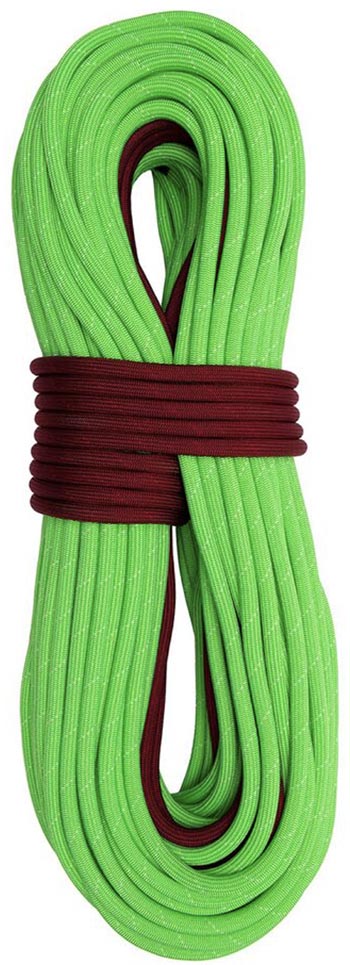 Category: All-around
Category: All-around
Diameter: 9.1 mm
Weight: 56 g/m
What we like: Built-in alert system lets you know when you're getting close to the rope's end.
What we don’t: Expensive.
Most accidents in climbing are due to user error, and one of the gravest but most common mistakes occurs when climbers lower or rappel off the end of their rope. While this issue can easily be avoided by paying close attention and tying a stopper knot, it doesn’t hurt to have equipment that lends a helping hand. Trango’s unique Agility 9.1 does just that, with a proprietary Red Flag treatment that marks the final five meters at each end with bright red dye. Whether you’re lowering your partner or rappelling yourself, the color change will make you well aware when you’re getting close to running out of rope.
In terms of the rope itself, the Agility 9.1 is the full package. Like the Edelrid Swift above, it's triple-rated for use as a single, double, or twin setup, which lends versatility for a variety of disciplines and objectives. Further, its nine UIAA fall count translates to impressive durability for such a thin line. But at $365 for the non-dry-treated model (and $445 for the Duo Dry), the Agility is undeniably pricey, and we always recommend practicing safe habits (e.g., tying off the end of your rope) regardless. But if you don’t mind the bump in cost and are intrigued by the Red Flag warning system and all-around versatility, the Agility is worth a look.
See the Trango Agility 9.1 Standard
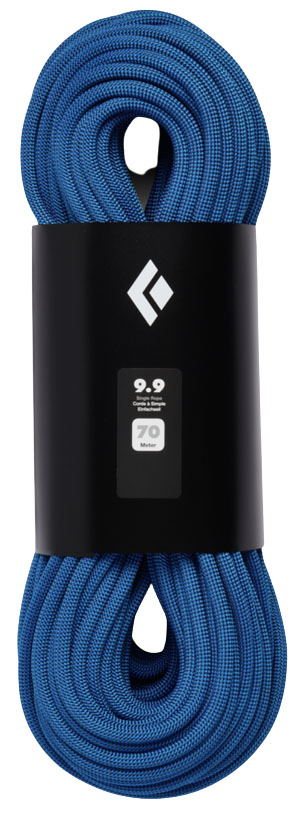 Category: Workhorse
Category: Workhorse
Diameter: 9.9 mm
Weight: 64 g/m
What we like: A great price and BD makes shopping easy.
What we don’t: Grows fuzzy over time.
The Black Diamond 8.6 above is our staff pick and a surprisingly durable and smooth-running rope for serious cragging and redpoint attempts (BD’s ropes haven’t always been praise-worthy). The 9.9 here lands at the other end of the spectrum with a much thicker design, making it a great pick for top roping, organized group cragging, and heavy, day in and day out use. And like the 8.6, the 9.9 is highly durable, supple and smooth right out of the box, and comes in just one color and four sizes, which simplifies decision making.
Keep in mind that the BD 9.9 does not come with any sort of dry treatment (neither on the core nor the sheath), so you’ll want to be sure to use it in dry conditions and with a rope bag or tarp underneath. Compared to our favorite workhorse rope above (the Sterling Velocity XEROS), the BD‘s lack of dry treatment does mean it will be quicker to grow fuzzy and soft. And while the 9.9 is a great option for beginner climbers just learning the ropes, you’ll likely want a skinnier rope as you progress: We also highly recommend Black Diamond’s 9.6, which comes in a similarly non-dry version for $220, in addition to a dry-treated, bi-pattern model (a nice safety measure for long pitches and while rappelling) for $330. But for those just starting out, the 9.9 is a total workhouse and a great value at just $210.
See the Black Diamond 9.9
![]() Category: All-around
Category: All-around
Diameter: 9.1 mm
Weight: 55 g/m
What we like: Durable enough for cragging but still light enough for the alpine.
What we don’t: Heavier than other 9.1 mm ropes.
BlueWater’s Icon is a well-loved rope that transitions between climbing environments better than most. With a 9.1-millimeter diameter and low weight, it’s light enough for hauling into the mountains or taking on your redpoint burn, but the durable sheath (which makes up 35% of the rope’s weight) is tough enough to take on the rigors of cragging. We’ve been impressed with how well this rope handles wear and tear, even on rock as sharp as Joshua Tree granite. And for only $253 for the 70-meter dry version, the Icon is affordable compared to much of its skinny-rope competition.
The Icon’s closest competitor is the Beal Joker below, which is a similar 9.1 millimeters in diameter. The Joker is 2 grams per meter lighter than the Icon, is rated as a single, half, and twin rope (read: more versatile), and comes with Unicore technology. Why do we rank the BlueWater higher? In the end, the proof is in experience rather than the numbers: while the Icon is slightly heavier and technically less durable than the Joker, we’ve found that its tightly woven sheath handles a season-long beating much better (the Icon gets nicely supple, while the Joker becomes soft and fuzzy). Considering both ropes are wildly strong, we’ll take the more durable sheath any day.
See the BlueWater Ropes Icon
 Category: All-around
Category: All-around
Diameter: 9.4 mm
Weight: 57 g/m
What we like: A durable and smooth-handling all-rounder from a reliable rope manufacturer.
What we don’t: Value falls short of the Mammut 9.5 Crag Dry above.
Sterling is one of the only rope makers that still manufactures their products in the U.S., but that’s not the only reason we like them. Put simply, their ropes are top-notch, ranging from lightweight models like the Duetto (8.4 mm) to the 10-millimeter T-10. Billed as a “guide favorite,” the Ion R here finds a happy medium at 9.4 millimeters in diameter, which is an ideal size for most recreational climbers. Unlike fatter lines, it moves smoothly through a Grigri and won’t weigh you down too much on long pitches, but it isn’t so thin that you’ll have to baby it, either. Tack on a really nice hand feel, and you get a high-quality all-rounder that can easily transition between the disciplines.
Like many of Sterling’s offerings, the Ion R is available both in standard weaves (with a middle mark) and a bi-pattern design ($340). Importantly, Sterling’s eco-friendly XEROS technology means that every single yard of fiber is water resistant, meeting UIAA dry treatment standards while minimizing waste and eliminating the use of harmful chemicals. We rank the Sterling here because it falls a little short of our top-ranked Mammut 9.5 Crag Dry in terms of value—for around the same price, the Mammut has a better UIAA fall rating (8-9 vs. the Sterling’s 5) and, in our experience, a much longer lifespan. But the Ion R is nevertheless a versatile, durable, and smooth-handling option to consider, and will keep you safe for a long time if cared for properly.
See the Sterling Ion R XEROS Dry
 Category: Workhorse
Category: Workhorse
Diameter: 10 mm
Weight: 61 g/m
What we like: Acts like a 10 mm, feels like a 9.7 mm.
What we don’t: You might be paying for features you don’t need.
We won’t try and hide it: we love Beal ropes, and we’re not alone. In fact, we have yet to meet anyone who isn’t psyched on their Beal line, whether it’s a 9.1 Joker or the 10-millimeter Tiger. And although 10 millimeter ropes quickly are going out of style, the Tiger still is relevant. Why? It simply feels skinnier than it is, has a staggeringly low impact force for its diameter, and doesn’t grow fat and fuzzy with age. In fact, at 61 grams per meter, the Tiger is as light as the 9.7-millimeter BlueWater Lightning above.
Sure, you could save some hard-earned money and opt for a rope like the Mammut 9.8 Crag Classic above, which would be a great choice if you only climb every now and then. But for the extra cash, the Tiger offers the added strength of Unicore technology and a bump in durability from Beal’s Dry Cover treatment. Add it all up and the Tiger is a one-size-fits-all workhorse that will serve you well from crag to big wall.
See the Beal Tiger Dry Cover
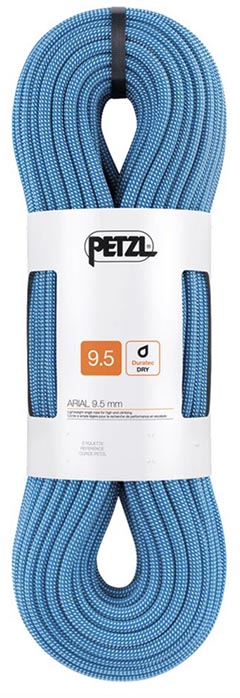 Category: All-around
Category: All-around
Diameter: 9.5 mm
Weight: 58 g/m
What we like: Durability and oh so supple.
What we don’t: Dry treatment does not meet UIAA standards.
If you’re an experienced climber looking for a one-size-fits-all kind of rope, the Petzl Arial is worth a look. This rope hits the sweet spot between durability and lightweight performance, all with the nice feel Petzl seems to nail every time. And when we say durable, we mean it: The UltraSonic Finish (Petzl’s version of Unicore) and Duratec Dry treatment add up to make the Arial an absolute workhorse of a 9.5 (sounds a bit like a paradox, doesn’t it?).
Unlike the Mammut Crag Dry, the Arial is not UIAA rated for water repellency—it's sheath is dry treated, but not its core—meaning it's more prone to absorbing water in real-deal mountain conditions. We've also found that the slick sheath slips easily through a Grigri, making us hesitant to recommend this rope for beginners. But for intermediate rock climbers who don’t need top-of-the-line dry treatment, the Arial holds steady with the competition in every other way and comes at a slightly lower price point.
See the Petzl Arial Dry
 Categories: Redpoint/alpine
Categories: Redpoint/alpine
Diameter: 9.1 mm
Weight: 53 g/m
What we like: Added reassurance of Unicore technology; 7 UIAA fall rating.
What we don’t: Grows very fuzzy with use.
The Beal Joker used to be our go-to climbing rope for light-and-fast alpine rock missions, until the advent of the Opera above. For those prioritizing weight savings, it’s a no-brainer when choosing between 48 and 53 grams per meter, especially given that both ropes have Beal’s impressive and confidence-inspiring Unicore technology. But we know many climbers who still are hesitant to trust their lives to an 8.5-millimeter single rope, and for these folks, the Joker is a logical compromise.
We used to love the Joker, and then we realized how often we were ordering a replacement. For a number of years, we blew through a Joker every season (and we only used it for multi-pitch climbing), retiring not because of coreshots or fall count, but because of how soft and fuzzy it became. Perhaps our ropes still had a lot of miles left, but they quite simply looked unsafe (a major challenge with ropes is knowing when to retire them, as a well-worn sheath does not necessarily denote a compromised core). BlueWater’s Icon above (also a 9.1) resists abrasion much better—so much so that we’ll even use it at the crag. All told, while the Joker is strong and lightweight, there are longer-lasting options available.
See the Beal Joker Golden Dry
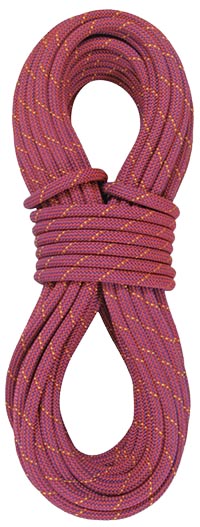 Category: Workhorse (gym only)
Category: Workhorse (gym only)
Diameter: 10.1 mm
Weight: 63 g/m
What we like: A no-frills gym rope for $120.
What we don’t: You won’t be using this rope outside.
For some of us, getting outside to climb simply is not a reality. Thankfully, climbing gyms are popping up like wildfire across the country, offering a fun and community-oriented vertical getaway right in the city. If this is your scene, it’s the perfect place to safely learn to lead climb. And for that, many gyms require you to bring your own rope.
Enter Sterling’s Slim Gym climbing rope. What differentiates this rope from the rest on our list? The most obvious answer is length: because most gyms don’t exceed 15 meters in height, bringing a 70-meter rope indoors is a bit excessive (not to mention more expensive). On that note, this rope keeps the price down by being everything you need for the indoor environment and nothing you don’t: no dry treatment, no focus on weight savings, and no Unicore technology. Alternatively, you could take a full-length rope and cut it in half, but we like the convenience of the purpose-built Slim Gym for gym climbers cutting their teeth.
See the Sterling Slim Gym 30m
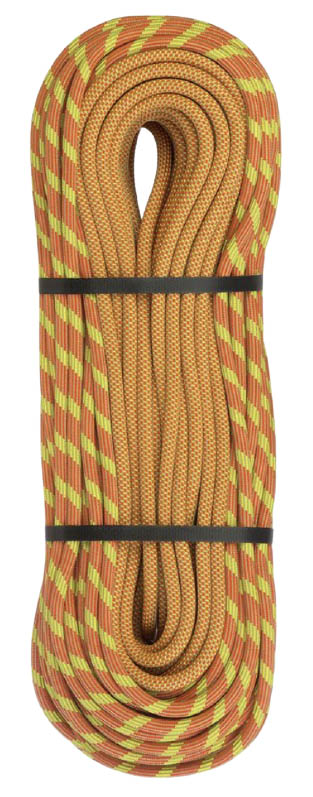 Category: Workhorse
Category: Workhorse
Diameter: 9.9 mm
Weight: 65.5 g/m
What we like: Low static elongation is great for top roping; UIAA waterproofing.
What we don’t: Expensive and heavy.
Ropes are Maxim’s specialty, and this Massachusetts-based company consistently churns out high-quality lines for the full range of climbing applications. The Glider is one of their most versatile offerings, with a 9.9-millimeter width, low static elongation (5% compared to the Sterling Velocity’s 8.6% and Mammut Crag We Care Classic's 8.8%), and a dry-treated core that keeps out moisture as well as dirt and dust. As a bonus, the Glider comes with a bi-pattern design and features a unique braiding pattern to facilitate less drag through the belay device than ropes of a similar diameter. Added up, the Glider is very durable and fun to use—great for high-use group settings and cragging alike.
At 65.5 grams per meter, the Glider is the heaviest model here, but this will be of little concern for those top roping at the crag. However, our biggest complaint about the Glider—and the main reason it falls at the bottom of the list—is price. For comparison, the Mammut 9.8 Crag above is lighter, has a 7-8-fall UIAA rating (compared to the Glider’s 7), and sells for $45 less (just think, that could buy you a few extra quickdraws). But there’s no denying that Maxim makes premium ropes, and intermediate to advanced climbers especially will want to take a look at the Pinnacle (9.5 mm) or Airliner (9.1 mm) models.
See the Maxim Glider Dry
| Rope | Price | Category | Diameter | Weight | UIAA Falls | Dry-Treated |
|---|---|---|---|---|---|---|
| Mammut 9.5 Crag Dry | $290 | All-around | 9.5 mm | 59 g/m | 8-9 | Yes |
| Mammut Crag We Care Classic 9.5 | $190 | All-around | 9.5 mm | 59 g/m | 6-7 | No |
| Edelrid Swift Eco Dry | $280 | Redpoint/alpine | 8.9 mm | 52 g/m | 7 | Yes |
| Sterling Velocity XEROS Dry | $290 | Workhorse | 9.8 mm | 62 g/m | 6 | Yes |
| Beal Opera Golden Dry | $280 | Redpoint/alpine | 8.5 mm | 48 g/m | 5 | Yes |
| Edelrid Hummingbird Pro Dry | $290 | All-around | 9.2 mm | 57 g/m | 8 | Yes |
| Black Diamond 8.6 Dry x 80m | $350 | Redpoint | 8.6 mm | 60 g/m | 5 | Yes |
| Mammut 9.8 Crag Classic | $200 | Workhorse | 9.8 mm | 64 g/m | 7-8 | No |
| BlueWater Lightning Pro Double Dry | $273 | All-around/workhorse | 9.7 mm | 61 g/m | 8 | Yes |
| Trango Agility 9.1 Standard | $365 | All-around | 9.1 mm | 56 g/m | 9 | No |
| Black Diamond 9.9 | $210 | Workhorse | 9.9 mm | 64 g/m | 7 | No |
| BlueWater Icon Double Dry | $253 | All-around | 9.1 mm | 55 g/m | 5 | Yes |
| Sterling Ion R XEROS Dry | $285 | All-around | 9.4 mm | 57 g/m | 5 | Yes |
| Beal Tiger Dry Cover | $250 | Workhorse | 10 mm | 61 g/m | 7-8 | Yes |
| Petzl Arial Dry | $270 | All-around | 9.5 mm | 58 g/m | 7 | Yes |
| Beal Joker Golden Dry | $320 | Redpoint/alpine | 9.1 mm | 53 g/m | 5-6 | Yes |
| Sterling Slim Gym 30m | $120 | Workhorse (gym only) | 10.1 mm | 63 g/m | 6 | No |
| Maxim Glider Dry | $245 | Workhorse | 9.9 mm | 65.5 g/m | 7 | No |
*All listed prices are for the 70-meter version of the rope, with the exception of the Black Diamond 8.6 (80 m) and the Sterling Slim Gym (30 m).
Single Ropes
Single ropes are the most common type of dynamic rope and the only style we include in our picks above. They usually fall between 8.5 and 11 millimeters in diameter, typically measure between 50 to 80 meters in length, and are designed to catch lead falls without the use of a second rope (the other element in catching a fall is your harness, and you can see our top climbing harness picks here). For any sort of single pitch climbing, and for the vast majority of multi-pitch, a single rope is what you’ll be using.
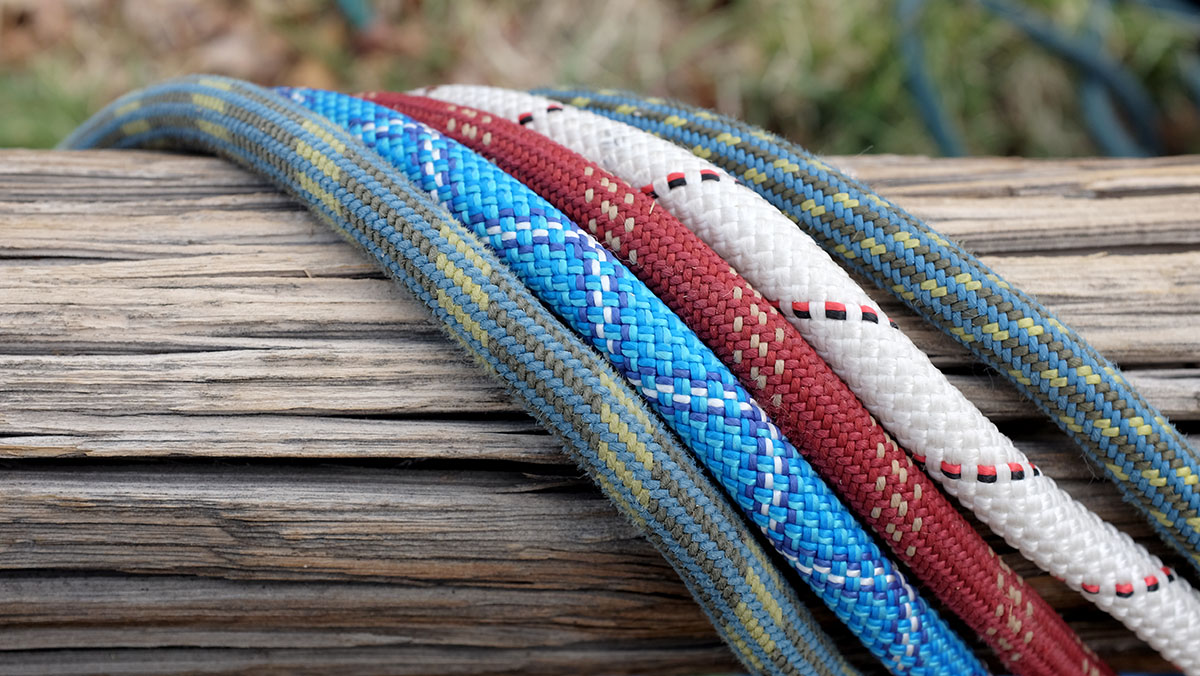
Half Ropes
Half ropes are a set of two thin ropes, usually both in the 8-millimeter range. They tend to be used most commonly in the alpine, where routes might meander, bad rock is a concern, or two ropes might be needed for rappelling a full 60 meters. Interestingly, double ropes are used more often than single ropes in the U.K., where routes are wander-y and protection is sub-optimal (half ropes exert a much lower impact force than single ropes). Half ropes are used together and generally clipped to every other piece, or one is used on the right side of the route and the other on the left to avoid rope drag. They are tested separately and each has its own fall rating. Climbing with half ropes involves an extra amount of rope management, so we’ll always opt for a single unless doubles are absolutely necessary. If you’re climbing in a party of three though, half ropes are the way to go. There are a number of single ropes in this article that are also rated as half ropes, such as the Edelrid Swift and the Beal Opera.
Twin Ropes
Twin ropes are roughly a millimeter thinner than half ropes, and simpler to use as well. In short, the climber treats the two ropes as one, clipping both into each piece of gear. Twin ropes are sometimes used for alpine climbing when climbing as a party of two (to allow for long rappels) or ice climbing, when you want to mitigate the amount of impact force on a screw—a skinnier rope means more stretch and thus less force. Twin ropes are rated as a pair (not tested individually) and thus are always meant to be used together. And like we mentioned above for half ropes, there are a few ropes that play triple duty, with the ability to be used in single, half, and twin configurations.
.jpg)
Both half and twin ropes often are referred to as “double ropes.” Some double ropes are rated as both half and twin, but when they are not, it’s important to understand what your ropes can used for safely. Two commonly-made errors go against manufacturer recommendation. First, climbers often clip two half ropes to one piece of gear. A fall in this situation would be less dynamic than ideal, and thus exert extra force on the gear (a big deal when you’re falling on an ice screw or marginal gear). The second error is climbing as a party of three on a set of twin ropes. Twin ropes are rated as a pair and are thus always meant to be used as a pair, not split up between two followers. While neither of these mistakes is likely to result in a fatality, it’s important to remember that user error is the most common reason for climbing accidents. Always use your gear per manufacturer recommendations.
Climbing ropes are a varied bunch, with primary distinctions coming in terms of diameter, dry treatment (or lack thereof), length, and price. Many climbers have a quiver of ropes for different needs: a short gym rope, a budget-priced workhorse for top roping, a thin rope for projecting routes, an even thinner rope for redpointing or alpine climbing. To help you select the right rope for your needs, we’ve broken our picks down into three categories: workhorse, all-around, and redpoint/alpine.
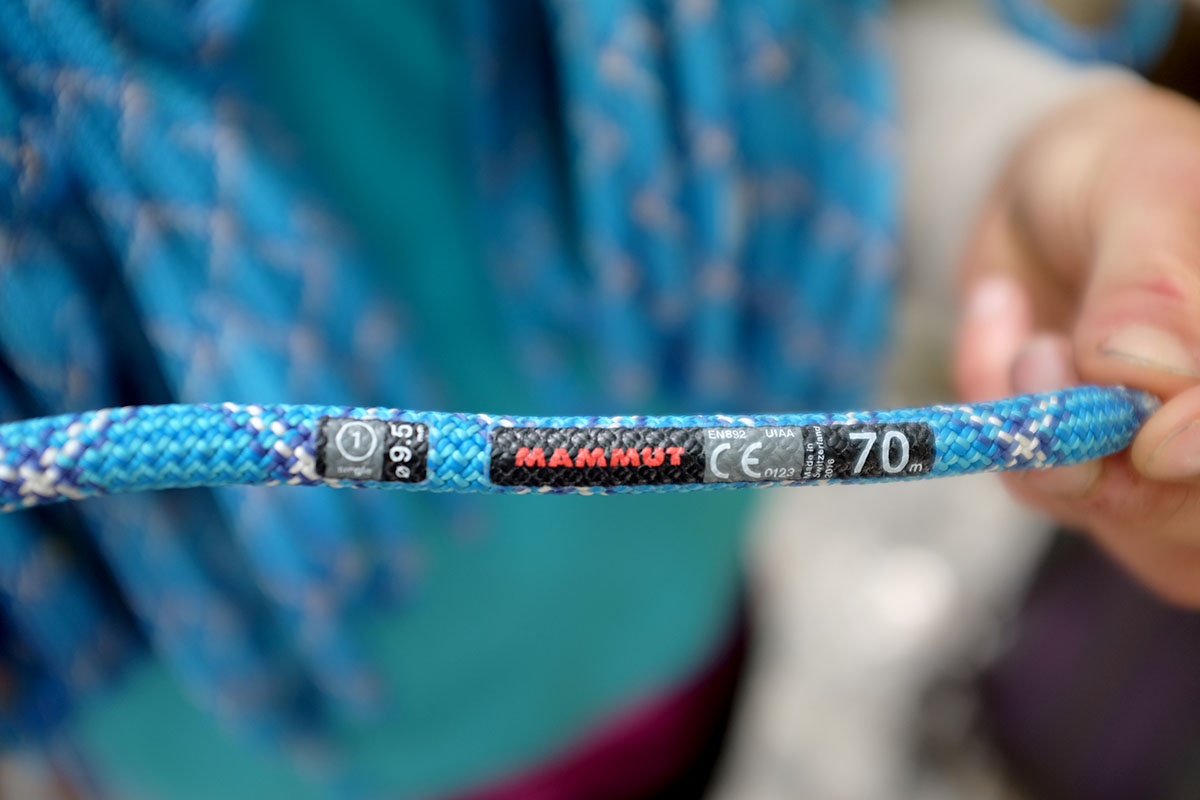
Workhorse
Workhorse ropes are our top picks for top roping, heavy use, and climbing around sharp rock. They are mostly defined by their diameter—by our definition, these ropes are 9.7 millimeters or thicker—but in general are priced more affordably than ropes in our all-around and redpoint/alpine categories, too. Workhorse ropes are ideal for those just getting into climbing, as they require less babying than skinnier ropes and often have a bit less stretch, which is great for top roping (for more on this, see the section on “Static vs. Dynamic” below). However, we don’t recommend these ropes for lead or multi-pitch climbing, as the extra heft will weigh you down and the thicker build is less ideal for clipping. But for the right environments, workhorse ropes are the most durable and affordable option. For solid performance, climb after climb, check out models like the Beal Tiger and Sterling Velocity.
All-Around
Ropes in our all-around category are the most versatile and popular of all climbing ropes. Clocking in between 9.1 and 9.6 millimeters in diameter, these ropes can do it all, including lead climbing, multi-pitch, and top roping. They’re not the most durable of the bunch (that crown goes to ropes in our workhorse category) and skinnier ropes offer better performance for redpointing and alpine climbing. But all-around ropes balance durability and a soft catch better than most, and their handling is top notch (pulling a skinny rope after a rappel is hard work!). There are so many to choose from, but the Mammut 9.5 Crag Dry and Edelrid Hummingbird are two of our favorite all-rounders.
.jpg)
Redpoint/Alpine
Ropes in our redpoint/alpine category, often referred to as “skinny ropes,” are generally between 8.5 and 9.1 millimeters in diameter. As a result, they’re the lightest of the bunch, the least durable, and the most dynamic—and often the most expensive, too. Owing to these properties, redpoint/alpine ropes are niche pieces geared toward experienced climbers pushing their limits: when you’re climbing 3,000 feet in a day, hiking 20 miles to approach a route, or pulling the crux on your project, a few grams per meter can make all the difference. In the past, ropes in the 8-millimeter range were thought of as dangerous or liable to sever on sharp rock, but with “Unicore” and similar technologies, they’re surprisingly strong and reliable. Do take care: assisted-braking belay devices—most notably, older versions of the Petzl Grigri—are often not recommended for ropes 8.9 millimeters and under (for more, see our article on belay devices). Our top picks in this category include the Edelrid Swift, Black Diamond 8.6 Dry, and Beal Opera.
As you can see in the comparison table above, most ropes come in a number of different lengths. Unless you have a certain route or purpose in mind, your best bet most of the time is going to be a 70-meter rope. There certainly are select crags where you’ll want an 80-meter rope, but if you climb at one of those you probably already know that. For the rest of us, you may be tempted to go with a 60-meter rope, but we recommend against that for two reasons. First, it’s a huge bummer when you look up at that beautiful 35-meter pitch that gets more stars than anything else at the crag, and you can’t do it because your rope is too short. 30 to 35-meter pitches are becoming more and more common, and you don't want your rope to hold you back. Second, even if you don’t ever climb a pitch longer than 30 meters, you’re likely to eventually wear out the ends of your rope and need to chop one or both of them. If you do that to a 70, you end up with a 60. Do it to a 60, and you’re stuck with a 50.
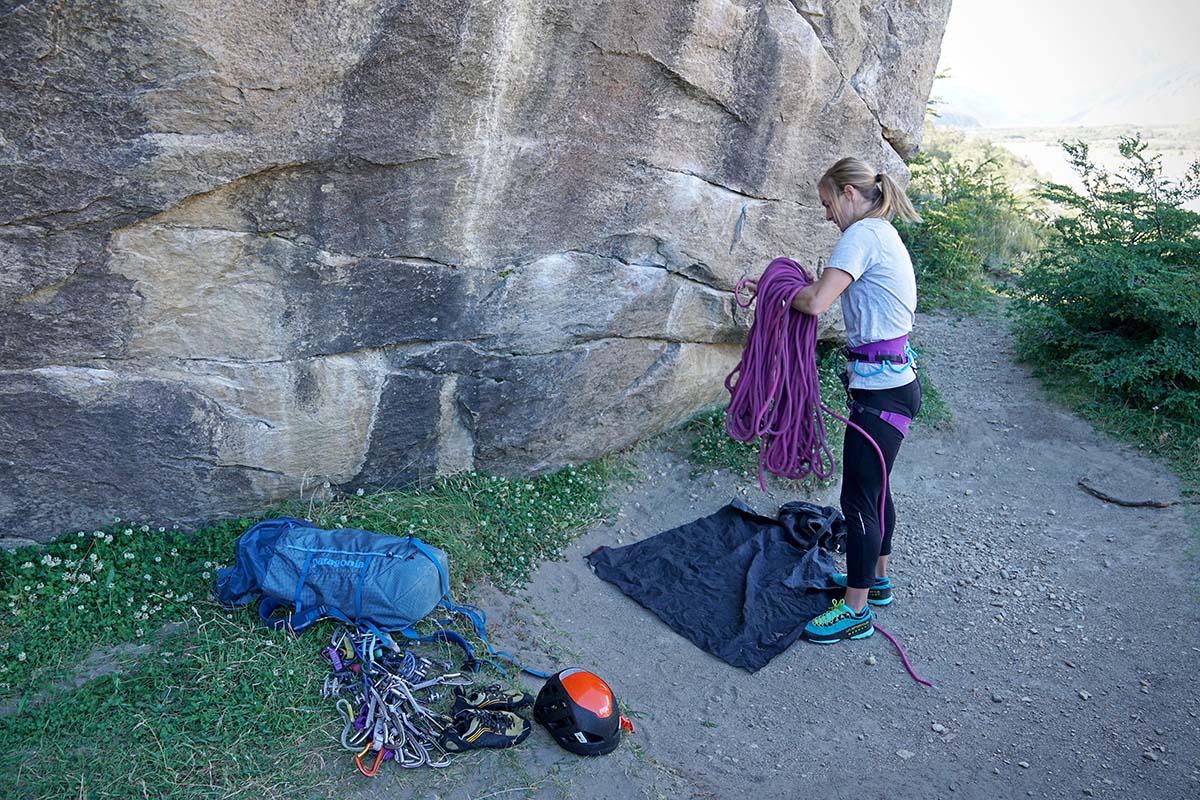
The one exception we would make is if you tend to climb mostly alpine or multi-pitch trad routes that have walk-offs instead of rappels. In that case, 60 meters probably is the length you are looking for. Hauling the extra 10 meters around all day is a pain, not to mention pulling it all up at the end of each pitch that originally was established on a shorter rope. And of course, if you’re looking for a rope for indoor climbing, 40 meters likely will be more than sufficient. Many rope manufacturers make ropes in this length specifically for the gym, such as the Sterling Slim Gym. But that said, you can also get away with buying a budget 70 or 80-meter rope with a friend, cutting it in half, and voilà: two ropes for the gym.
Many climbing companies now design a selection of their ropes with a dry treatment that repels water and moisture. Dry-treated ropes have a number of benefits: first, they do not grow heavy with water weight when wet. Second, they have a longer life span, as falling on a wet rope causes the rope to age quicker than falling on a dry one. Third, dry treatments do a pretty good job (while they last) of keeping out dirt and other grime. Lastly, rope manufacturers have conducted tests showing that ropes with dry treatment resist abrasion more than ropes without dry treatment.
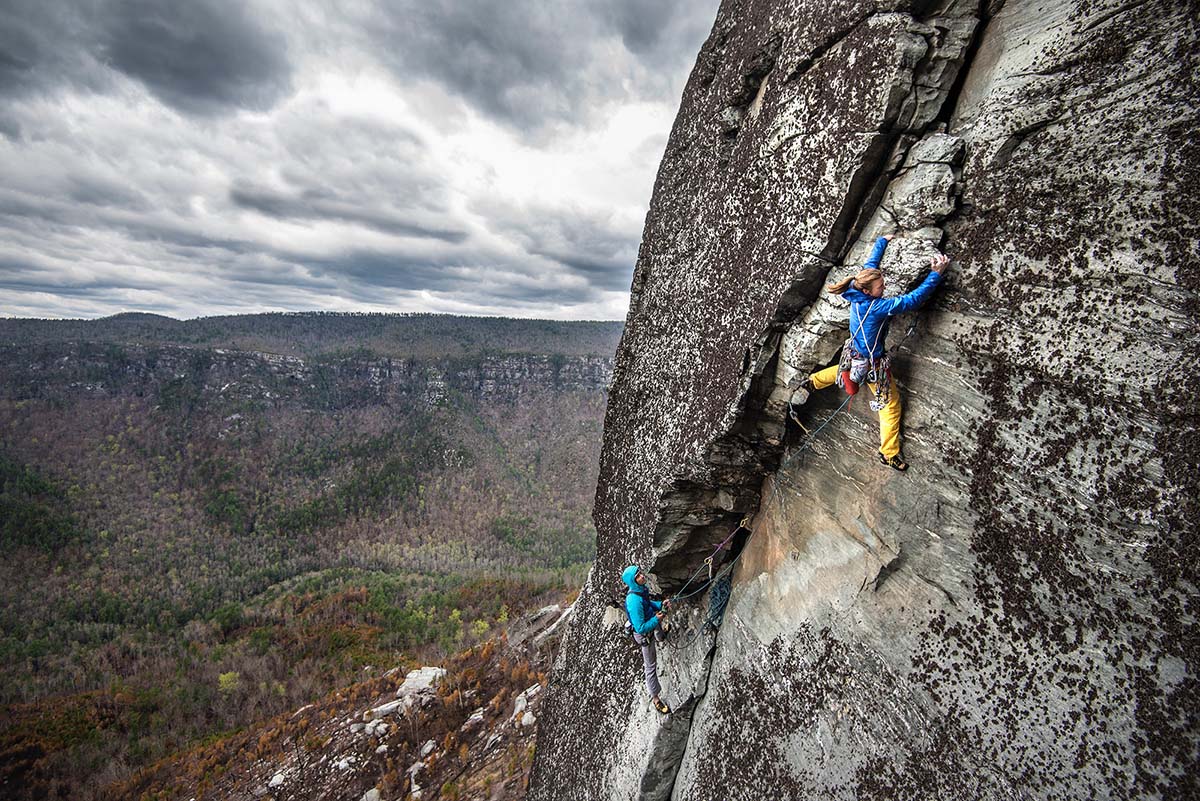
On some ropes, just the sheath is dry treated, and on others, it’s the core and the sheath (herein lies the difference between Beal's Dry Cover and Golden Dry treatments). In the latter case, the rope often is referred to as “double dry." Here's a little more information about double dry: In 2014, the UIAA (the international governing body that develops and maintains safety standards for climbing equipment) created a water repellency certification for ropes. To meet this standard, a rope must absorb less than 5% of its weight in water when fully soaked (a rope like the UIAA-certified Edelrid Swift Eco Dry absorbs less than 2%). Interestingly, the UIAA found that many ropes labeled as “dry coated” actually absorb 20 to 40% of their weight. Thus, if you’re looking for a true water repellant rope, pay attention to the UIAA rating. Most double dry ropes should meet this standard.
The question remains: do you need a dry-treated rope? Maybe not, but it certainly won’t hurt having the extra durability. If you normally climb in dry conditions and are just looking for a long-lasting rope that won’t grow fuzzy with abrasion, a rope with a dry-treated sheath will do the trick, like the Petzl Arial Dry. But if you are an alpine climber, ice climber, or mountaineer, you’ll likely be looking for a double dry rope, and one certified as water repellent by the UIAA. Some of our favorite dry-treated ropes are the Mammut Crag Dry and the Edelrid Swift Eco Dry.
.jpg)
What are the downsides to dry-treated ropes? The obvious answer is that they generally are $50 to $100 more expensive than their non-treated counterparts. Additionally, most of the time they have a more slippery feel (especially initially) than other ropes. For climbers who get their start in the gym on fat, fuzzy ropes, the transition to belaying on a dry-treated line merits a bit of caution. Furthermore, contrary to popular belief, treated ropes still can become quite dirty (the dirt does not penetrate the rope, but rather sticks to the treatment). All things considered, we think ropes with dry treatment generally are superior and consider the extra upfront investment worth it for a much longer lasting and more abrasion-resistant rope.
It's pretty simple when it comes to ropes: weight is a function of length and diameter. The thinner and shorter a rope, the lighter it will be. There are a few minor exceptions: the Beal Tiger, for example, is exceptionally lightweight for its diameter, and Black Diamond ropes tend to be heavy for their size. But overall, the lightest ropes are the skinniest, and vice versa.
For the vast majority of climbers who crag close to the car, rope weight is a non-issue. But for alpine climbers with long approaches, multi-pitchers who are pulling hundreds of meters of rope in a day, or the redpoint sport climber, every ounce counts. In these scenarios, a skinnier rope is a sendy-er rope. Opting for a short rope (60 m, or even 50 m) can be an excellent way for multi-pitch climbers to shed weight as well.
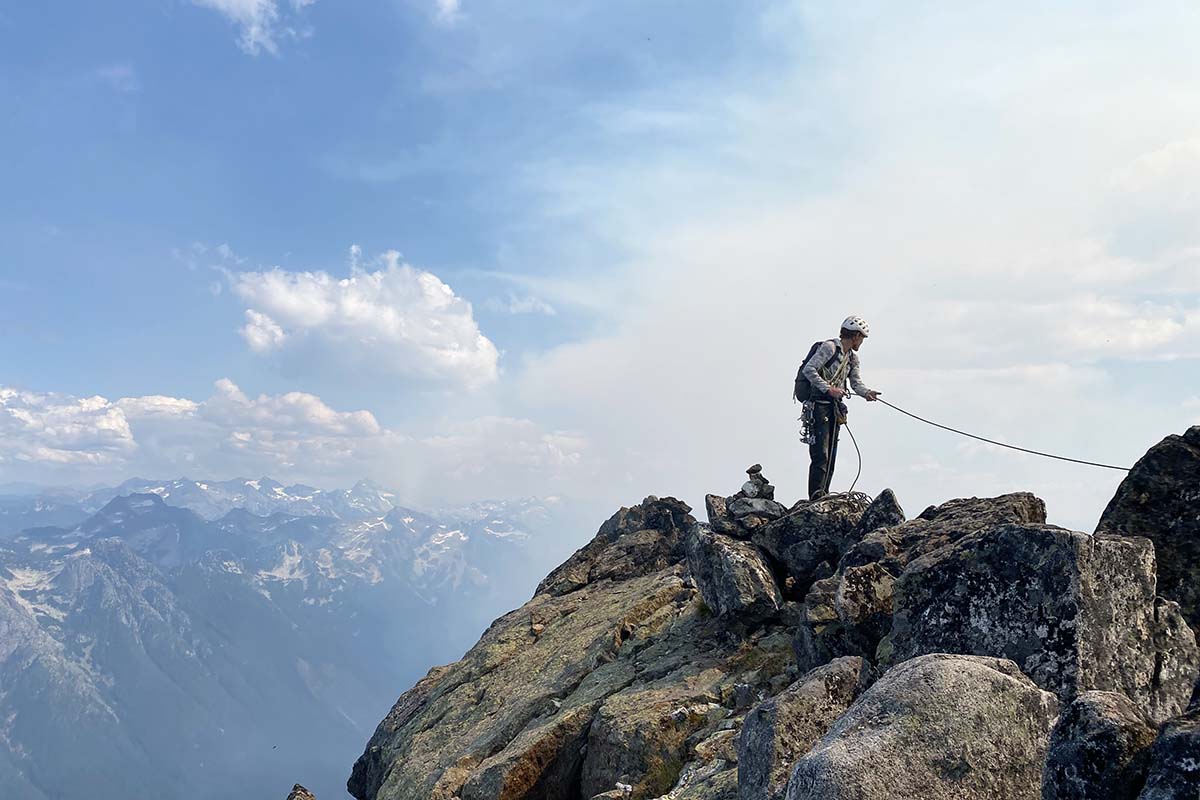
The sheath of a rope is the outer weave that is visible to the naked eye. The job of the sheath is to handle smoothly and protect the core, which runs along the center of the rope and is responsible for bearing the load. An ideal core will catch a lot of falls while still maintaining its elasticity.
It’s worth noting that not all sheaths and cores are created equal. Some ropes have more bulk in the sheath to resist abrasion—if your local crag features particularly rough rock, look for a rope with a higher sheath-to-core ratio, also expressed as the sheath percentage (most are in the 30 to 40% range). In addition, depending on a sheath’s weave or design, we see a lot of variation in terms of durability and hand feel. Where possible, we address these observations in the write-ups above.
One thing worth noting is the development of Unicore technology, which for the first time has managed to unite the sheath and core of ropes. Although Beal was the innovator, similar concepts are now being adopted by most major rope manufactures: Edelrid has their LinkTec and Maxim their Platinum rope, for example. In our opinion, this technology offers game-changing resilience to coreshots and sharp edges and provides an extra level of assurance, especially for single lines (a pretty convincing video can be found here). We've been really impressed by Unicore, and it's no coincidence it’s featured in a number of our top ropes, including the Beal Opera.
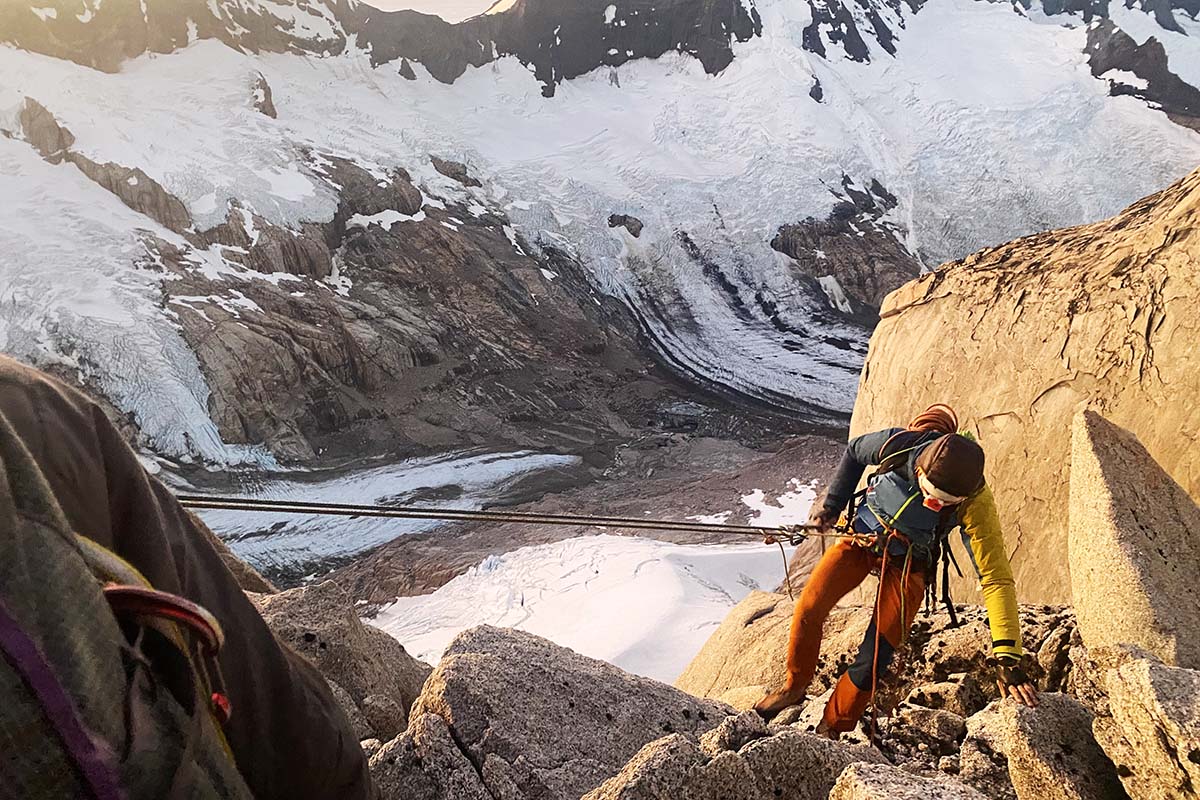
Middle marks are super valuable. They give you a good reference of how far the leader has climbed, tell you if you can lower the climber safely to the ground, and show you the point at which both ends are even when rappelling with a single rope. All ropes should come with some sort of a marking to let you know where the middle is—generally a black patch or sewn-in threads—but if yours didn’t, it’s not too difficult to make one. You can mark the middle with a permanent marker (some companies explicitly warn against this, while others have never identified a problem with ink), or sew a few pieces of colored thread (shallowly) into the rope’s sheath.
Bi-pattern or bi-color weave is another technique that rope manufacturers use to distinguish the middle of the rope—many ropes are available in both standard weaves (with middle markers) and bi-patterns. On bi-pattern ropes like the BlueWater Lightning Pro, the pattern of the weave changes halfway, meaning one half of the rope has one pattern, and the other half has another. All things being equal, we’d opt for a bi-pattern rope over one with a simple middle mark for the ease of knowing where we're at without having to find a small middle mark. But unfortunately, bi-pattern ropes can be significantly more expensive than their single-pattern counterparts, and for many it’s not really worth the money. Plus, if you end up chopping one of your rope ends due to wear or a core shot, your bi-pattern middle mark will be off forever.
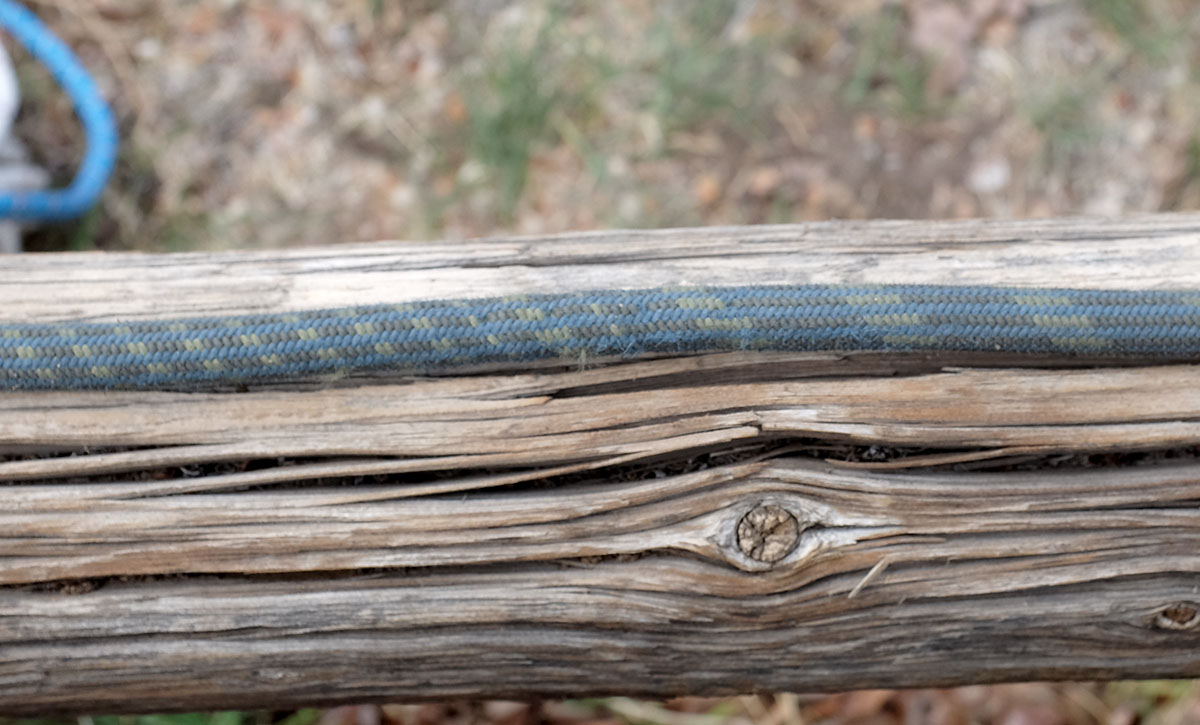
If you're brand new to climbing, the terms static and dynamic may have you a little confused. A static rope is one that only stretches minimally (less than 5% elongation), and a dynamic rope is one that stretches a good bit more (about 5 to 10% elongation). For any sort of lead climbing, it’s imperative to use a dynamic line. No exceptions. Taking a lead fall on a static line can have disastrous consequences, especially in the spine, cervical spine, and internal organs. Static lines can be useful for rigging top-ropes, and sometimes for top-roping itself: most gyms will use a semi-static rope for top-roping, which is right around 5% elongation. Finally, a static line can be useful as a tag line or pull cord used only for rappelling or hauling gear.
In terms of dynamic ropes, there are two elongation figures that climbers should look at: the dynamic elongation and the static elongation. Static elongation is the amount (in a percentage) a rope stretches with 80 kilograms of static weight on one end. This is an important statistic for cragging: generally, a lower number here (less stretch) is better for top roping or hang-dogging purposes. On the other hand, dynamic elongation is the distance a rope stretches during a lead fall. Less dynamic stretch can keep the climber off a ledge or the ground, but more stretch reduces impact force on both the climber and the gear. In general, cragging workhorses will have less elongation (both static and dynamic), and redpointing (when you want a soft catch) or alpine climbing lines (when you want a lower impact force on marginal gear) will have more. To illustrate, the Sterling Velocity XEROS has a 28.8% dynamic elongation, while the Beal Opera's is 37%.
.jpg)
The UIAA (or the Union Internationale des Associations d’Alpinisme) is the lead certifying body for climbing gear, with standards for over 20 types of safety equipment including helmets, harnesses, carabiners, and more. In terms of climbing ropes, their safety test specifies a fall rating (all certified climbing ropes must be rated to at least five UIAA falls), which is a measure of the dynamic strength of a rope. It’s important to keep in mind that a UIAA fall does not describe a typical lead fall—the process of testing is very different from a climbing fall and entails forces of a different magnitude—and does not mean you need to retire your rope after your fifth whipper. That said, it’s a good marker for how durable a rope is: the higher the fall rating, the longer your rope should last with regular wear and tear (our chart-topping Mammut 9.5 Crag Dry, for example, is rated to 8-9 falls). That said, you can never rule out the possibility of a random core shot, and it’s a good practice to check your rope often for soft spots and abrasions.
A climbing rope is no small investment, and there are a number of steps you can take to ensure it stays in the game for as long as possible. First off, make sure to alternate which end you climb on. This will spread out the wear and tear of the tie-in point, and ensure that fall impacts are distributed throughout the length of the rope. Second, we recommend purchasing a rope bag or tarp to protect your rope at the crag (one of our favorites is the Black Diamond Burrito Bag, although you can improvise with an Ikea bag or a Tyvek ground tarp). Having a barrier between the ground and your rope will keep small rocks and sand from working their way into the sheath and abrading the strands over time.
.jpg)
Finally, it’s a good practice to wash your rope from time to time. This doesn’t have to be complicated: just throw it in your washing machine (top loader or front loader, it doesn’t matter) on the gentlest cycle with cold water. If you don’t have a washing machine, the bathtub will do. You don’t need to add soap—although for a particularly dirty rope, a mild soap or a rope-specific soap is your best bet. Hang your rope to dry in the shade (exposure to sun will degrade the sheath), making sure it’s completely dry before putting it away. Finally, store your rope coiled or flaked in a cool, dry place.
We often harp on redundancy in climbing: use two to three pieces in your anchor, tie your rope through both points of your harness, double back your knot, etc. Yet when it comes to the rope—arguably your most important lifeline—there’s no redundancy to speak of: it’s standard practice to rely on just the one, single strand. And while it’s difficult to overstate the strength of a climbing rope, it is paramount that the rope is in good shape in order to safely hold a fall. So when is it time to retire your rope? Here are a few things to consider.
.jpg)
First, climbing ropes all have a finite lifespan. Even if you’ve never used your rope, manufacturers still recommend that you retire it after 10 years. Further, a used rope might not show any signs of wear but still be ready for retirement. The British Mountaineering Council recommends that with regular, once or twice a week use, you should retire your rope after about three years. In the meantime, it’s important to check your rope often, looking for fuzzy areas, stiff or soft spots, discoloration, or cuts—these abnormalities are signs that its integrity is compromised. The good news is, you’ll often notice these weaknesses near the ends, in which case you can cut them off and still have a workable rope (just remember that your 70 m is now a 62 m).
Most importantly, it’s important to err on the side of caution. When we’re undecided about whether or not to continue using a rope (or any piece of gear), we always ask ourselves, “Is it worth it?” In almost every case, a few hundred dollars is a small price to pay for peace of mind and safety on the rock.
Back to Our Top Climbing Rope Picks Back to Our Climbing Rope Comparison Table